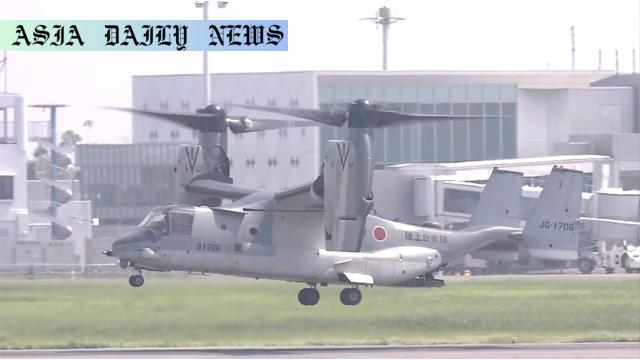Osprey Deployment: The Defense Ministry transfers all 17 Ospreys to boost southwestern Japan’s security amid increased maritime activity.
Japan’s Defense Ministry begins Osprey deployment to Saga Prefecture.
The deployment aims to strengthen defenses against rising Chinese activities.
Safety concerns remain due to the history of Osprey-related accidents.

Introduction to Osprey Deployment in Japan
Japan’s Defense Ministry has initiated a significant strategic operation by deploying Osprey transport aircraft to Saga Prefecture in southwestern Japan. This move represents Japan’s commitment to strengthening its defensive capabilities amid growing maritime security threats, particularly from an increasingly assertive China. The deployment involves transferring 17 Osprey aircraft currently stationed at Camp Kisarazu in Chiba Prefecture to a newly constructed facility located west of Kyushu Saga International Airport. This marks a pivotal moment in Japanese self-defense efforts and reflects the country’s proactive approach to safeguarding its territorial waters and airspace.
Details of the Deployment Process
The first of the Osprey aircraft arrived at the new site in Saga on Wednesday morning, having made a scheduled stopover at another facility in Kumamoto Prefecture. Each of the remaining 16 aircraft will follow a similar process, being transferred individually over the coming weeks. The operation is scheduled to conclude by mid-August. The meticulous planning and phased execution underscore the ministry’s emphasis on safety and precision, especially given the aircraft’s previous history of operational accidents.
Addressing Safety Concerns
The Osprey, despite being a highly capable transport aircraft, has faced scrutiny due to multiple accidents since it began operations with US forces in 2007. Notably, a fatal crash off Kagoshima in 2023 resulted in the loss of eight military personnel. Acknowledging these challenges, the Defense Ministry has reassured the public that strict safety protocols are being upheld throughout this deployment. The aircraft’s performance, maintenance, and operational guidelines are under stringent review to prevent any potential mishaps and to foster public trust in the military’s capability to handle such advanced machinery responsibly.
The Strategic Implications
Positioning the Osprey aircraft in Saga Prefecture is not just a logistical move but a strategic pivot. Located in the southwestern region of Japan, this site provides a critical vantage point amidst rising tensions in East Asia. The redeployment aims to counteract China’s expanding maritime activities and influence in the area. By reinforcing its southwestern defenses, Japan demonstrates its preparedness and intent to maintain sovereignty over its territorial integrity. The placement of these versatile aircraft also enhances the Ground Self-Defense Force’s rapid deployment capabilities, crucial in responding to emergencies or conflicts effectively.
Conclusion: A Step Towards Enhanced Regional Security
This Osprey deployment signifies a determined effort by Japan to address both emerging and long-standing security challenges. Although concerns surrounding safety due to the aircraft’s operational history remain, the implementation of rigorous oversight and adherence to strict protocols reflects the ministry’s commitment to high standards. With this move, Japan is not just reacting to external threats but proactively positioning itself to take on future challenges. This careful balance between strategic necessity and operational caution is commendable and demonstrates Japan’s broader defense strategy’s inclusivity.
Commentary
Japan’s Defense Strategy Takes a Bold Turn
The recent deployment of Osprey aircraft to Saga Prefecture marks a bold step forward in Japan’s defensive strategy. As regional tensions heighten, particularly with China’s maritime assertiveness, Japan has recognized the need to bolster its strategic positions in the southwest. The careful placement of these aircraft in Saga provides the country with a robust operational edge, underlining the importance of addressing security challenges proactively. This move speaks volumes about Japan’s commitment to safeguarding its territorial sovereignty and preparing for contingencies while maintaining transparency and building trust among its citizens.
Balancing Safety with Strategic Necessity
One of the most prominent discussions surrounding the Osprey deployment is its safety track record. With a history of accidents, including the devastating 2023 crash near Kagoshima, it is understandable that the public may harbor concerns. Japan’s Defense Ministry has been quick to address these apprehensions by ensuring strict adherence to safety protocols and operational scrutiny. This transparent approach is critical not only in managing risks but also in bolstering public confidence in the country’s military initiatives. The thorough planning and phased implementation underscore the ministry’s commitment to both security and safety.
Impacts Beyond National Security
Beyond its immediate defensive implications, the Osprey deployment may have broader geopolitical impacts. By reinforcing its southwestern defenses, Japan is sending a clear signal to its neighbors and allies. This action is not solely about protecting its borders but also about contributing to regional stability. It opens avenues for deeper cooperation with allies like the United States, enhancing joint operational capabilities and strategic collaborations. Japan’s proactive stance could encourage other nations in the region to reevaluate and strengthen their own defense strategies.
A Crucial Moment for Japan’s Military Evolution
The deployment of the Ospreys to Saga Prefecture reflects a pivotal moment in Japan’s military evolution. It signifies a shift towards a more assertive yet responsible defense posture. The move aligns with the country’s broader security framework, balancing assertive strategies to deter potential threats while adhering to principles of transparency and accountability. As Japan continues to navigate the complex regional dynamics of East Asia, such initiatives will likely play a crucial role in shaping its future defense landscape and reinforcing its position on the global stage.


